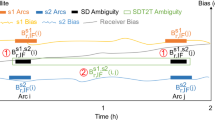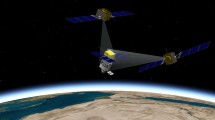Abstract
The satellite laser ranging (SLR) echo signals of the multi-reflector defunct spacecraft contain multiple distance information corresponding to the corner cube reflectors (CCRs) in different installation positions. The relative distances between different CCRs and their variations depend on the rotation state of the object. However, the rotation of many defunct spacecraft is relatively slow over a short observation time span. In this case, estimating the effective rotation state is still difficult due to the limited amount of information. In this paper, a slow-rotating multi-reflector defunct spacecraft CZ-2C R/B (NORAD ID 31114) is taken as an example to develop a new method to estimate the rotation state through laser ranging measurements from a single short arc. The reference vector method is used in new attitude representation. The reduced expressions between the relative distances, their first derivative and rotation state are derived. Through the state estimation method combining grid search and differential corrections, the reduced parameters are estimated efficiently and accurately. In addition, the consistent orientation of maximum principal axis of inertia of CZ-2C R/B are obtained, which provides effective information for the subsequent research.






Similar content being viewed by others
References
Chen, C.C., Andrews, H.C.: Target-motion-induced radar imaging. IEEE Trans. Aerosp. Electron. Syst. 1, 2–14 (1980)
Dai, J.S.: Euler–Rodrigues formula variations, quaternion conjugation and intrinsic connections. Mech. Mach. Theory 92, 144–152 (2015)
Di, N., Zhu, W., Wu, R.: Introduction to long march series launch vehicles: the CZ-2 series (part I). Aerosp. China 8, 27–33 (1997)
Hall D, Africano J, Archambeault D, et al.: AMOS observations of NASA’s IMAGE satellite. In: The 2006 AMOS Technical Conference Proceedings, Kihei, HI, 2006 (2006)
Koshkin, N., Shakun, L., Korobeynikova, E., et al.: Monitoring of space debris rotation based on photometry. Odessa Astron. Publ. 31, 179–185 (2018). https://doi.org/10.18524/1810-4215.2018.31.147807
Kou, P., Liu, Y., Weijun, Z., et al.: Axial attitude estimation of spacecraft in orbit based on ISAR image sequence. IEEE J. Sel. Top. Appl. Earth Observ. Remote Sens. 14, 7246–7258 (2021). https://doi.org/10.1109/JSTARS.2021.3096859
Kucharski, D., Kirchner, G., Schillak, S., et al.: Spin determination of LAGEOS-1 from kHz laser observations. Adv. Space Res. 39(10), 1576–1581 (2007). https://doi.org/10.1016/j.asr.2007.02.045
Kucharski, D., Otsubo, T., Kirchner, G., et al.: Spin axis orientation of Ajisai determined from Graz 2 kHz SLR data. Adv. Space Res. 46(3), 251–256 (2010). https://doi.org/10.1016/j.asr.2010.03.029
Kucharski, D., Kirchner, G., Koidl, F., et al.: Attitude and spin period of space debris Envisat measured by satellite laser ranging. IEEE Trans. Geosci. Remote Sens. 52(12), 7651–7657 (2014). https://doi.org/10.1109/TGRS.2014.2316138
Liang, Z., Han, X., Fan, C., et al: Laser ranging observation and orbit determination of rotating reflective CZ-2C rocket stage. In: The 20th International Workshop on Laser Ranging, Potsdam, Germany (2016)
Lin, H.Y., Zhu, T.L., Liang, Z.P., et al.: Tiangong-1’s accelerated self-spin before reentry. Earth Planets Space (2019). https://doi.org/10.1186/s40623-019-0996-8
Milani, A., Gronchi, G.F., Knežević, Z., et al.: Orbit determination with very short arcs II. Identification. Icarus 179(2), 350–374 (2005). https://doi.org/10.1016/j.icarus.2005.07.004
Pavlis, E.: Geophysical parameters from laser ranging to the LAGEOS and ETALON satellites. In: The 34th COSPAR Science Assembly, 2nd World Space Congress, Houston, TX, USA, 2002 (2002)
Pearlman, M.R., Degnan, J.J., Bosworth, J.M.: The international laser ranging service. Adv. Space Res. 30(2), 135–143 (2002)
Pittet, J.N., Šilha, J., Schildknecht, T.: Spin motion determination of the Envisat satellite through laser ranging measurements from a single pass measured by a single station. Adv. Space Res. 61(4), 1121–1131 (2018). https://doi.org/10.1016/j.asr.2017.11.035
Schildknecht, T., Silha, J., Pittet, J.N., et al: Attitude states of space debris determined from optical light curve observations. In: The 1st IAA Conference on Space Situational Awareness (ICSSA), Orlando, FL, USA, 13–15 November 2017 (2017)
Shan, M., Guo, J., Gill, E.: Review and comparison of active space debris capturing and removal methods. Prog. Aerosp. Sci. 80, 18–32 (2016). https://doi.org/10.1016/j.paerosci.2015.11.001
Sommer, S., Rosebrock, J., Cerutti-Maori, D., et al.: Temporal analysis of Envisat’s rotational motion. JBIS J. Br. Interplanet. Soc. 70(2–4), 45–51 (2017)
Song, C., Lin, H.Y., Zhao, C.Y.: Analysis of Envisat’s rotation state using epoch method. Adv. Space Res. 66(11), 2681–2688 (2020). https://doi.org/10.1016/j.asr.2020.09.007
Tapley, B.D., Bettadpur, S., Watkins, M., et al.: The gravity recovery and climate experiment: mission overview and early results. Geophys. Res. Lett. 31(9), L09607 (2004). https://doi.org/10.1029/2004GL019920
Wang, P., Almer, H., Kirchner, G., et al: kHz SLR application on the attitude analysis of TechnoSat. In: The 21st International Workshop on Laser Ranging, Canberra, Australia (2018)
Wertz, J.R.: Spacecraft Attitude Determination and Control, vol. 73. Springer, Berlin (2012)
Funding
This research was supported by the National Natural Science Foundation of China (Grant No. 12073083 and 11533010) and the Youth Innovation Promotion Association, CAS (Grant No. 2018353).
Author information
Authors and Affiliations
Corresponding author
Ethics declarations
Competing interests
Author declares that he has no competing interests.
Availability of data and material
The data that support the plots within this paper and other findings of this study are available from the corresponding author upon reasonable request.
Code availability
Not applicable.
Additional information
Publisher's Note
Springer Nature remains neutral with regard to jurisdictional claims in published maps and institutional affiliations.
Guest Editors: Xiyun Hou, Massimiliano Vasile and Alessandra Celletti.
This article is part of the topical collection on Dynamics of Space Debris and NEO.
Rights and permissions
About this article
Cite this article
Song, C., Liang, ZP., Lin, HY. et al. Rotation state estimation of slow-rotating multi-reflector defunct spacecraft through laser ranging measurements from a single short arc. Celest Mech Dyn Astron 134, 30 (2022). https://doi.org/10.1007/s10569-022-10083-7
Received:
Revised:
Accepted:
Published:
DOI: https://doi.org/10.1007/s10569-022-10083-7




